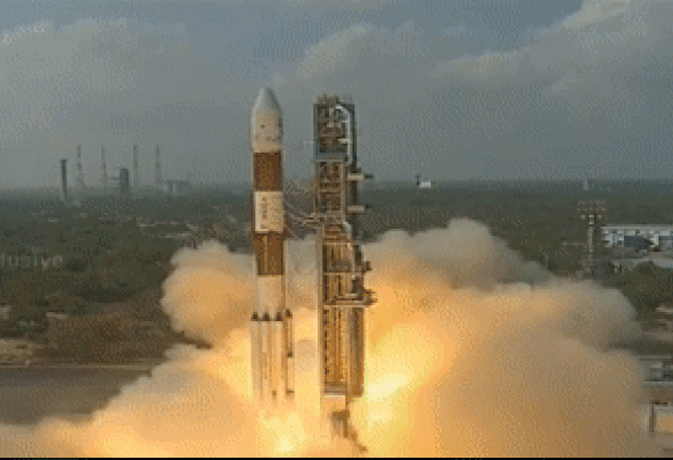Today in space - Chandrayaan-1 Today (October 22, 2008) is the day of the unmanned lunar mission launched by the Indian Space Research Organization.
Chandrayaan-1 is a manned lunar mission launched into space by the Indian Space Research Organization on October 22, 2008. Its main purpose is to study the distribution of various minerals and chemicals on the Earth's surface and to make a three-dimensional map of the entire Moon's surface with high accuracy. Indian Space Research Organization's Polar Satellite Launch Vehicle PSLV The Chandrayaan I cell was orbited at 240 km x 24000 km. The spacecraft was then positioned in a 100 km polar orbit around the moon with the help of its own forward system. The Chandrayaan I spacecraft will have an orbital system and a lunar landing system together.
The project also includes
research equipment from multinational space agencies such as NASA, the European
Space Agency and Bulgaria. NASA's Moon Mineralogy Mapper, NASA's M3 Mineralogy
Mapper, mounted on Chandrayaan-1, has studied the collision of the lunar
collusion probe. This study found that there is a large amount of water on the
surface of the moon.


India successfully launched the
PSLV C-3 spacecraft on October 22, 2001. The Polar Satellite Launch Vehicle
(PSLV) is an irreversible missile launcher launched by the Indian Space
Research Organization (ISRO). This is ISRO's first operational launch vehicle.
The virus will be able to launch 1600-kg satellites into the 620 km solar
ecliptic and 1050-kg satellites into the geostationary orbit. PSLV-Series is
very reliable. Has performed fifteen successful series of launches as of
September 2009. One of its variants, the PSLV-C11, was used to launch the moon.
From 1994 to 2019, more than 500 satellites were launched, 46 of which were
launched 48 times in a row. Of these, 319 satellites are foreign and 109 are
Indian.

On October 22, 1968, NASA's
Apollo 7 spacecraft landed safely in the Atlantic Ocean after orbiting the
Earth 163 times. The Apollo program was a series of human spaceflight programs
implemented by the United States from 1961–1972. It aims to land a man on the
moon and bring him back to Earth safely by the 1960s. This goal was achieved in
1969 with the Apollo 11 program. The project was extended to the early 1970s to
carry out early anthropological research on the moon.

The Apollo program included 11
manned flights from Apollo 7 to Apollo 17. All of these were launched from the
Kennedy Space Center in Florida. Unmanned test flights from Apollo 2 to Apollo
6. Apollo 1, which was scheduled to be the first manned flight, caught fire
during a missile test and all three astronauts were killed. A small 1-B missile
was used in the first manned flight. All subsequent flights used the powerful
Saturn V. Two of these (Apollo 7 and Apollo 9) are Earth orbits. Apollo 8 Apollo
10 Earth orbit. The other 7 missions are landing missions. (Of these, Apollo 13
failed.)

Apollo 7 tested the Apollo
Command and Service Component (CSM) in Earth orbit. Apollo 8 tested CSM in
lunar orbit. Apollo 9, Lunar Roof (LM), tested Earth's orbit. Apollo 10, Lunar
Cell (LM), tested the Moon's orbit. Apollo 11 was the first manned spacecraft
to land. Apollo 12 was named the first manned spacecraft to land on the moon.
Apollo 13 failed an attempt to land on the moon but succeeded in landing the
crew safely on Earth following an explosion into a catastrophic flight. Apollo
14 resumes lunar exploration program Apollo 15, the LM with lunar exploration
capability, introduced a new level of longevity, and a lunar rover. Apollo 16
was the first lunar landing on the Moon's high ground. Apollo 17 is the first
voyage of a scientist and astronaut, and the final voyage of the project.
Source By: Wikipedia.
Information: Dr. P. Ramesh, Assistant
Professor of Physics, Nehru Memorial College, Puthanampatti, Trichy.







.jpg)
No comments:
Post a Comment